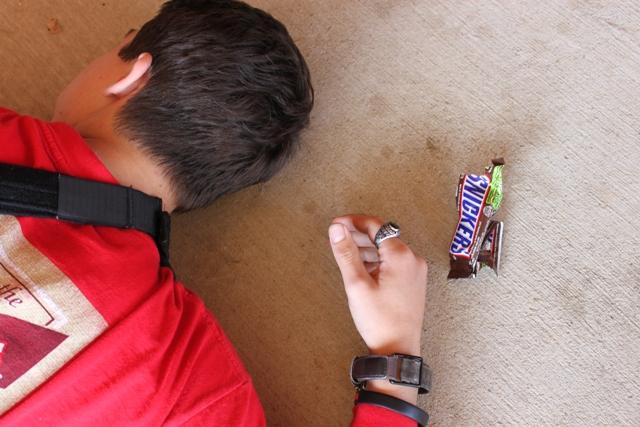Life With Food Allergies
Even candy bars can kill; everything from Twix to Snickers to Butterfinger have a sneaky way of getting into our lives. Kissing someone or hugging someone with the allergy can send them into a panic attack or even an allergy attack.
Migraines, gastro-intestinal discomfort, sniffles, red eyes, coughing, hives, lung constriction — all possible symptoms of an allergic reaction. For me, the severity of the symptoms depend on what I’ve ingested and how much of it. I’ve lived in a state of fear for the last fourteen years of my life. I have the possibility of ingesting something that could possibly kill me, or leave me bedridden for day. The killer is usually anaphylaxis, a severe reaction to an allergen in the immune system. If not treated immediately, it will kill the allergic person. It certainly does: it kills about 150 people a year (Beasley 17).
I was seven years old when I had a first-hand experience with anaphylactic shock. We had gone out to get Subway and stopped at a bakery nearby. On vacation, we used to get sweets, which we generally related to where we were staying. On Saint Simon’s Island, there was a little bakery which a friend had recommended we visit. I bought an oatmeal raisin cookie, my favorite. We asked the woman at the counter if the cookie had any peanuts in it, and she said no. Well that answer was deemed extremely incorrect about forty-five minutes later when I’d eaten maybe a third of the cookie, and my face started to itch. I was coughing and sneezing, which was normal due to my allergies to trees and flowers. My mother knew something wrong when I told her I was struggling to breathe. She scooped me up, dropped me in the car and called my father. I was in and out as I was rushed to a 24 hour clinic at around two in the afternoon. Mom kept making comments about how my lips were turning blue, and my father was scared. Eleven years later, that continues to be the scariest day of my life.
Most people with food allergies can relate to what I’m saying. According to Food Allergy Research and Education (F.A.R.E), 15 million people in the US have food allergies. That’s 4% of all adults, and 8% of all children with severe food allergies, many of those allergies having the possibility of killing them. At first glance, the numbers seem so small but the population of the US is around 313.9 million people. When you calculate it, 21% of the US population has food allergies, and those are only the cases we know about. To live with a food allergy is to live with a disability, especially if the allergy is just developing or if it occurs later in life. I, for one, did not know anyone was allergic to corn until an ear of it made me violently ill and I started to do some research. Some symptoms don’t seem like an allergic reaction until it’s too late.
For years I had been plagued by depression and I drowned it in food. Little did I know, my depressive episodes, my migraines, and my stomach issues had all been caused by a hidden corn allergy, never making itself known until I was at my wit’s end. To take corn out of my diet has been the hardest thing, but I have begun to live a far healthier life without it. Our bodies are not made to ingest the grain, yet it resides in nearly every name brand food known to man. My corn allergy is far different from my peanut allergy, but that doesn’t mean it’s not an allergy. It is still debilitating, it is still hard to live with, but it’s not going to kill me in the end of it all.
None of my allergies define me by any means. They simply exist, and I cater my diet, as well as my habits, to them. So what if I couldn’t eat PB&J on early release days when I was little? I still ate something. So what if I have to ask what’s in everything when I go to a barbeque? I’m just trying to keep everyone from listening to me complain, or worse yet, vomit. So what if I pass my allergies on to my children? I’ll make sure they know how to live their lives because I had to teach myself. So what if my boyfriend is afraid to kiss me after he’s eaten peanuts? I’d rather him be scared to kill me, than willing to take the chance.
When you live life with a food allergy, the hardships of others start to make sense. I never kept kosher, but I can’t eat corn-fed beef. My little sister didn’t have any religious restrictions either, but she can’t have any dairy at all. Imagine for a moment what it’s like to be me, or her, or the 15 Million other allergic Americans. Maybe then it’ll be understood why we back away from you slowly when we can smell our killer on your breath.
______________
Beasley, Sandra. Don’t Kill the Birthday Girl: Tales from an Allergic Life. New York: Random House, 2011. Print.

Abbie Findley hides in the shadows of the band room from the moment she steps into North Forsyth. She prefers the arts to new people and wishes to spread...


